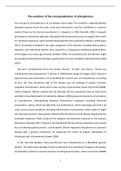The evolution of the conceptualization of schizophrenia
The concept of schizophrenia is of a relatively recent origin. The condition, originally labelled
dementia praecox (from the Latin ‘early-onset dementia’), was first identified as a distinct
mental illness by the German psychiatrist E. Kraepelin in 1896 (Kyziridis 2005). Kraepelin
promoted an essentialist approach arguing that dementia praecox was an organic illness with
an inherited component, which existed independently of the psychiatrist (Maatz, Hoff & Angst
2015). According to Kraepelin, the major symptoms of the disorder including hallucinations,
delusions and attentional deficits were caused by a progressive intellectual deterioration,
which began at an early age (Davison & Neale 1998). He postulated that the disorder might
be caused by chemical brain damage resulting from a chronic metabolic autointoxication (Noll
2007).
The term ‘schizophrenia’ (from the Greek ‘schizein’, ‘to split’, and ‘phren’, ‘mind’) was
coined by the Swiss psychiatrist P.E. Bleuler in 1908 (Ashok, Baugh & Yeragani 2012). Bleuler’s
approach was also essentialist, as he identified the ‘clinical core’ of schizophrenia. According
to him, the most prominent sign of the disease was the splitting of psychic functions
(cognition and emotion), which led to a loss of unity of personality (Fusar-Poli & Politi 2008).
Unlike Kraepelin, Bleuler claimed that the disorder did not necessarily have an early onset
and did not inevitably lead to full dementia. Bleuler (1950) proposed a hierarchy of symptoms
of schizophrenia, distinguishing between fundamental symptoms including abnormal
associations, autism, abnormal affectivity and ambivalence, which seemingly occurred in all
cases, and accessory symptoms including hallucinations and delusions, which might or might
not have been present. Having been influenced by the work of Freud, Bleuler argued that the
secondary symptoms likely resulted from adaptive and defensive reactions to the primary
disturbance (Stengel 1957). However, he maintained that the primary symptoms were caused
by an underlying organic process. Like Kraepelin, Bleuler regarded schizophrenia as a physical
disease with a genetic component. He supported the notion of eugenic sterilization of
individuals with schizophrenia (Joseph 2004).
In the next few decades, many psychiatrists saw schizophrenia as a Mendelian genetic
disease. This reductionist biological view contributed to the realization of eugenic sterilization
of psychiatric patients in several countries including Nazi Germany, where more than 220000
1
, people with schizophrenia were sterilized or executed between 1934 and 1945 (Torrey &
Yolken 2010).
Following the horrors of psychiatric sterilization and genocide, which many viewed as ‘the
moral failings’ of biological psychiatry, the focus began to shift toward identifying social
causes of schizophrenia. In 1948, the German psychiatrist, F. Fromm-Reichmann developed
the concept of the ‘’schizophrenogenic mother’’, arguing that schizophrenia was caused by a
combination of maternal overprotection and rejection (Neill 1990). According to Fromm-
Reichmann, schizophrenogenic mothers demanded emotional expression and dependency
from their children, yet they simultaneously rejected their displays of affection and
dependency. As a result of such conflicting messages, these children withdrew and eventually
developed schizophrenic behaviours. Focussing on the whole family unit, Bateson and
colleagues (1956) proposed the double-bind hypothesis, arguing that schizophrenia might
develop in individuals, who are repeatedly subjected to pathological forms of communication
from their family members.
During the 1960’s, many critics of psychiatry promoted a social constructionist view of
schizophrenia. According to social constructionism, reality is the product of human activity
and not something objective and self-evident that is just waiting to be discovered. Scheff
(1966) applied the labelling theory to schizophrenia, postulating that it was merely a social
role assigned to individuals who violated conventional behavioural norms/residual rules.
Laing (1976) contended that the label of schizophrenia was ‘’a social fact’’ that was used to
control individuals, whose experiences and behaviours did not conform to the reality defined
by society. Furthermore, Szasz (1960) maintained that mental illnesses were ‘’problems in
living’’ and not disease entities, as they were defined by deviations from norms stated not in
biological but psychosocial and ethical terms. He argued that disease, as defined by
pathologists, can only affect the body. Since the mind is not an organ, it cannot be diseased.
Therefore, mental illness is an oxymoron.
Kendell (2004) objected to this argument by pointing out that there has never actually been
a universally agreed upon definition of disease in medicine, and that Szasz’s definition was
extremely narrow placing far too much emphasis on cellular pathology, while completely
ignoring that incapacity and suffering are also fundamental attributes of disease.
Furthermore, many have criticized Szasz arguing that he failed to acknowledge the severe
2




